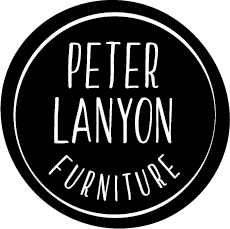Traditional methods of furniture construction
When I trained at Rycotewood college in 1998, the process we were taught was basically to design a piece of furniture, then visit a sawmill armed with templates and a cutting list, to select timber that fitted the design. My approach these days turns that on its head. I visit a local woodland, where I select individual trees from sustainably managed plantations that will inform the design of new pieces. I seldom sketch, preferring to allow the timber to direct the work. My process is not one of imposing on the material, but of allowing a design to evolve as a collaboration with the wood.
The care and time put into each selection and creation are there from the very beginning of an idea. Every piece of wood and every tool is used with care and respect for both the material and the integrity of the finished piece.
Traditional methods of furniture construction, even in handmade furniture, wood is often sourced from abroad (either from Europe, America, or worse still from tropical rainforests) in uniform boards of wood. This makes perfect sense if timber is to be packed into containers for shipping to other parts of the world. These planks and sheets require straight lengths of the tree, often from mature trees which are then standardised in a sawmill. Any sections of the tree that are not straight enough to produce the standard lengths of wood must be discarded or chipped. This wastes beautiful sections of the tree and also reduces the amount of wood that can be used from each cut. Carefully managed woodland can produce a sustainable range of wonderful trees for use in furniture making and other uses, while helping to create biodiverse and abundant ecosystems, but it is essential that each tree that is used, is used to the maximum. I love using shapes and textures of wood that would never make it through the sawmill process. I love to see those shapes in designs that remind us that wood is a natural and alive resource, by integrating the exquisite shapes that nature builds into trees. Our multi-stem handmade wooden lamps especially give the impression of a small coppice of local Devon woodland.
At every stage of sourcing and crafting my sustainable wooden furniture, I seek to source local materials, reduce carbon miles, waste nothing and make designs that champion nature’s beauty. I am always learning and exploring new ways to make everything we do as sustainable as possible. It can be a struggle to buy and do things nowadays which don’t have a negative impact on the environment and it is just as much of a struggle to find ways to equally offset our negative impacts from daily life. You can be confident when buying a piece of my sustainable furniture that it has been nurtured from seeding to seating.
Have a look at our collection of handmade furniture in our online shop and see if you could bring a beautifully crafted slice of Devon’s sustainable woodlands into your home or workplace. Each project can be created from a selection of different wood species, so you are guaranteed to have a very personal item, whether you buy directly from our shop or commission your own piece. Most of our pieces are made to order due to storage so when your item arrives it will smell of fresh craftsmanship with zero chemical emissions filling your home.
If you would like to learn more about our sustainably sourced wood, please visit our previous blog, alternatively, if you are looking to source your own sustainable wood to continue on a project you started in one of our workshops, why not call in on Green sweet chestnut from Carl, Mark or Mike at Sawmills Devon.
